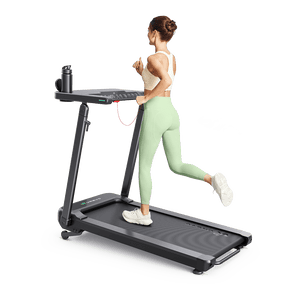The global shift towards home-based workouts has spotlighted versatile fitness equipment that doesn't consume much space. Among the frontrunners are the walking pad and stationary bike-both lauded for their convenience and effectiveness. While the walking pad offers the simplicity of walking with the compactness to stow away under a desk, the stationary bike provides a rigorous cardiovascular workout in a static location. Each has its own charm and utility, but choosing the right one depends on more than just the available floor space in your home.
Pros and Cons of Walking Pad
A walking pad, essentially a compact, foldable treadmill, is designed for walking at various speeds. Its primary appeal lies in its space-saving design and ease of use, making it an ideal choice for those with limited living space or who prefer gentle, consistent exercise.
Pros
- Space Efficiency: The walking pad's design is a testament to ingenuity in space management. Unlike a full-sized treadmill, most models of walking pads can be folded down to a slim profile and slipped under furniture such as sofas or beds. This feature is particularly valuable in urban apartments or studios where floor space is a premium commodity. The ability to stow away the device when not in use means your living area remains uncluttered, making the walking pad an excellent choice for maintaining a tidy and versatile living space.
- Simplicity: One of the most significant advantages of the walking pad is its straightforwardness. It eliminates the intimidation factor often associated with more complex gym equipment. To start, one simply steps onto the pad and begins walking. There's no intricate setup or array of settings to navigate, which makes it appealing not only to tech-savvy users but also to those who prefer a no-frills exercise routine. This ease of use encourages consistency in maintaining an active lifestyle, as the simplicity of operation is a huge motivator for regular use.
- Versatility: The walking pad's real charm lies in how effortlessly it melds with the rhythms of daily life. It supports a multitasking lifestyle - you can walk while you manage your emails, brainstorm work projects, or unwind with a TV series. This integration ensures that you can incorporate physical activity into your routine without having to carve out additional time expressly for exercise. It's especially beneficial for those who spend long hours at a desk, offering a practical solution to increase mobility and reduce the health risks associated with prolonged sitting.

Cons
- Limited Intensity: Primarily designed for walking, it lacks the capability for high-intensity workouts that burn calories more efficiently.
UREVO Foldi 3S Smart Treadmill
Height-Adjustable Design
Oversize Work Station
9% Auto Incline
Superior Shock Absorption
Benefits and Drawbacks of Stationary Bike
Stationary bikes have been stalwarts in the fitness equipment arena for decades. Available in various styles, including upright and recumbent, they cater to a range of fitness levels and comfort preferences.
Benefits
- Cardiovascular Improvement: They provide excellent cardiovascular workouts that can be adjusted for intensity, aiding in heart health and calorie burn.
- Low Impact: Particularly beneficial for those with joint issues as cycling reduces strain on the knees and ankles compared to running.
- Customizable Workouts: With features like adjustable resistance and simulated terrains, they offer a variety of challenging workouts.
Drawbacks
- Space Requirements: Generally larger and less flexible with placement compared to walking pads.
- Cost: Depending on the model and features, they can be more expensive than other home exercise options.
Walking Pad vs. Stationary Bike: How to Choose
Choosing between a walking pad and a stationary bike hinges on several factors including your fitness goals, physical condition, and personal preferences.
Fitness Goals
If your primary fitness objective is to increase physical activity levels in a manageable and sustainable way, the walking pad is an excellent choice. It is particularly suited for those who aim for moderate exercise, prefer walking over cycling, or seek an easy way to fit more movement into their daily routine. While the stationary bike excels at providing high-intensity cardiovascular workouts that can accelerate weight loss and improve heart health, the walking pad offers a straightforward, low-intensity alternative that can still contribute to overall fitness and calorie expenditure, albeit at a slower pace.
Physical Limitations
For individuals dealing with joint pain, back issues, or mobility restrictions, the walking pad's low-impact nature stands out as a significant advantage. Walking is a natural motion less likely to exacerbate joint problems, making it a gentler option compared to the cyclic motion of biking, which might be uncomfortable for some. The walking pad allows you to set your own pace and easily adjust your walking speed without the need to manipulate settings frequently, providing a comfortable and accessible form of exercise.
Space and Lifestyle
When space is a crucial factor in your decision-making process, the compact design of the walking pad becomes highly relevant. Its ability to fold and be stored discreetly under furniture or in small spaces makes it particularly appealing for those living in apartments or homes with limited space. This feature also enhances the walking pad's integration into a multi-functional area, such as a home office or living room, allowing you to exercise without dedicating a permanent spot to bulky equipment. In contrast, stationary bikes, although effective, typically require a fixed amount of space and are not as easily relocated or hidden away.

Final Words
Both the walking pad and stationary bike offer distinct advantages that can cater to different exercise needs and living situations. When making your choice, reflect on what fits best into your daily routine, meets your health objectives, and aligns with your physical requirements. Whether it's the walking pad's integration into a sedentary lifestyle or the intensive exertion offered by a stationary bike, the best choice is one that you will use regularly and fits seamlessly into your life. Thus, consider your options carefully and choose equipment that you will enjoy and benefit from in the long run.
FAQs
1. Are walking pads suitable for elderly users or those with balance issues?
Walking pads are generally considered safe for elderly users or those with balance issues due to their low speed settings and the ability to use nearby furniture for support.
2. Are walking pads suitable for running?
Most walking pads are specifically designed for walking and have a lower maximum speed limit, which typically does not exceed 4-6 mph. They are not built for running due to their motor capacity and belt size. Users looking for running capabilities should consider compact treadmills designed for both walking and running.
3. How long does it take to assemble a walking pad?
Assembling a walking pad is generally straightforward and can usually be done in under an hour. Most models come partially assembled with clear instructions to complete the setup. It's a simple process that typically requires fitting the arms or console onto the base.
4. What floor types are suitable for placing a walking pad?
Walking pads work best on hard, flat surfaces. To protect the floor and reduce noise, it's advisable to place a mat under the device. This setup helps in stabilizing the walking pad and minimizing any potential damage to the floor.
5. What should I consider when choosing between a walking pad and a stationary bike for rehab purposes?
For rehabilitation, the choice depends on the specific needs and advice of a physical therapist. Walking pads are suitable for those needing gentle, steady rehabilitation exercises, while stationary bikes are better for rebuilding strength and cardiovascular health without putting too much strain on the joints.
Read More
- Is the Treadmill Walking Pad Effective? Exploring Benefits and Drawbacks – Urevo
- Worth It to Get a Foldable Walking Pad Treadmill: A Comprehensive Anal – Urevo
- Walking Treadmill Pad: Your Secret Weapon for Effective Weight Loss – Urevo
- How Can You Burn Calories at Work? – Urevo
- Small Under Desk Treadmill: 30 Minutes Walking Enough for Fitness? – Urevo


































